MITS5505 Knowledge Management: Case Study and Frames
VerifiedAdded on 2022/10/31
|15
|3238
|199
Homework Assignment
AI Summary
This assignment solution addresses various aspects of knowledge management. It begins with brainstorming techniques to identify ways companies can reward employees and enhance their perception of personal worth, followed by the application of the nominal group technique and consensus decision-making to determine the best solutions. The assignment then delves into knowledge codification, using frame-based representation for different entities such as a horse, a student, and an airline pilot. It further explores the skills required for successful knowledge developers, comparing the effectiveness of different approaches. Finally, the solution analyzes a case study of KM implementation failure at a global company, identifying factors contributing to the failure across different stages of knowledge management, including technology, project management, and content-related issues. The analysis utilizes inductive analysis, unitizing, and categorizing to uncover the root causes of the project's shortcomings.
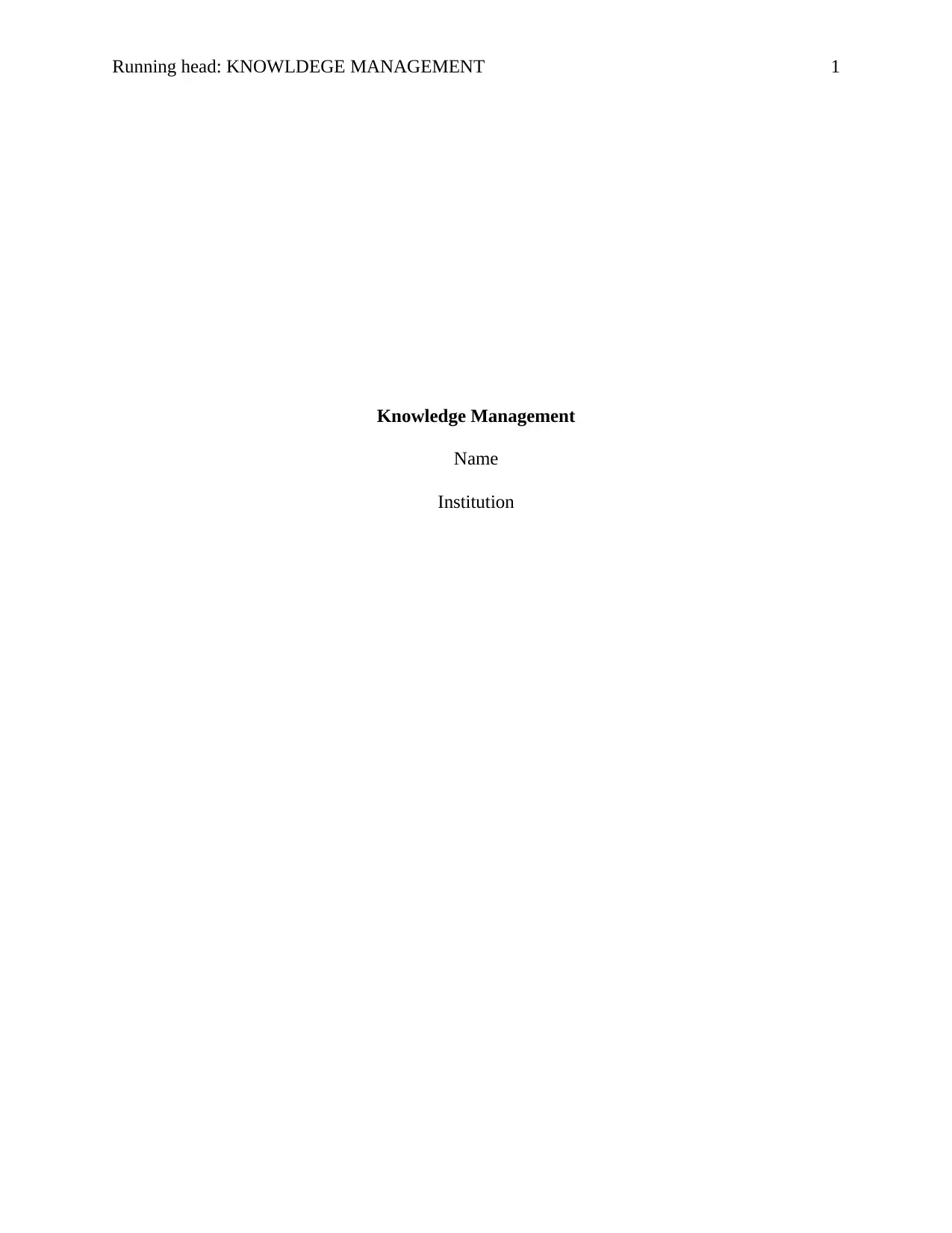
Running head: KNOWLDEGE MANAGEMENT 1
Knowledge Management
Name
Institution
Knowledge Management
Name
Institution
Paraphrase This Document
Need a fresh take? Get an instant paraphrase of this document with our AI Paraphraser
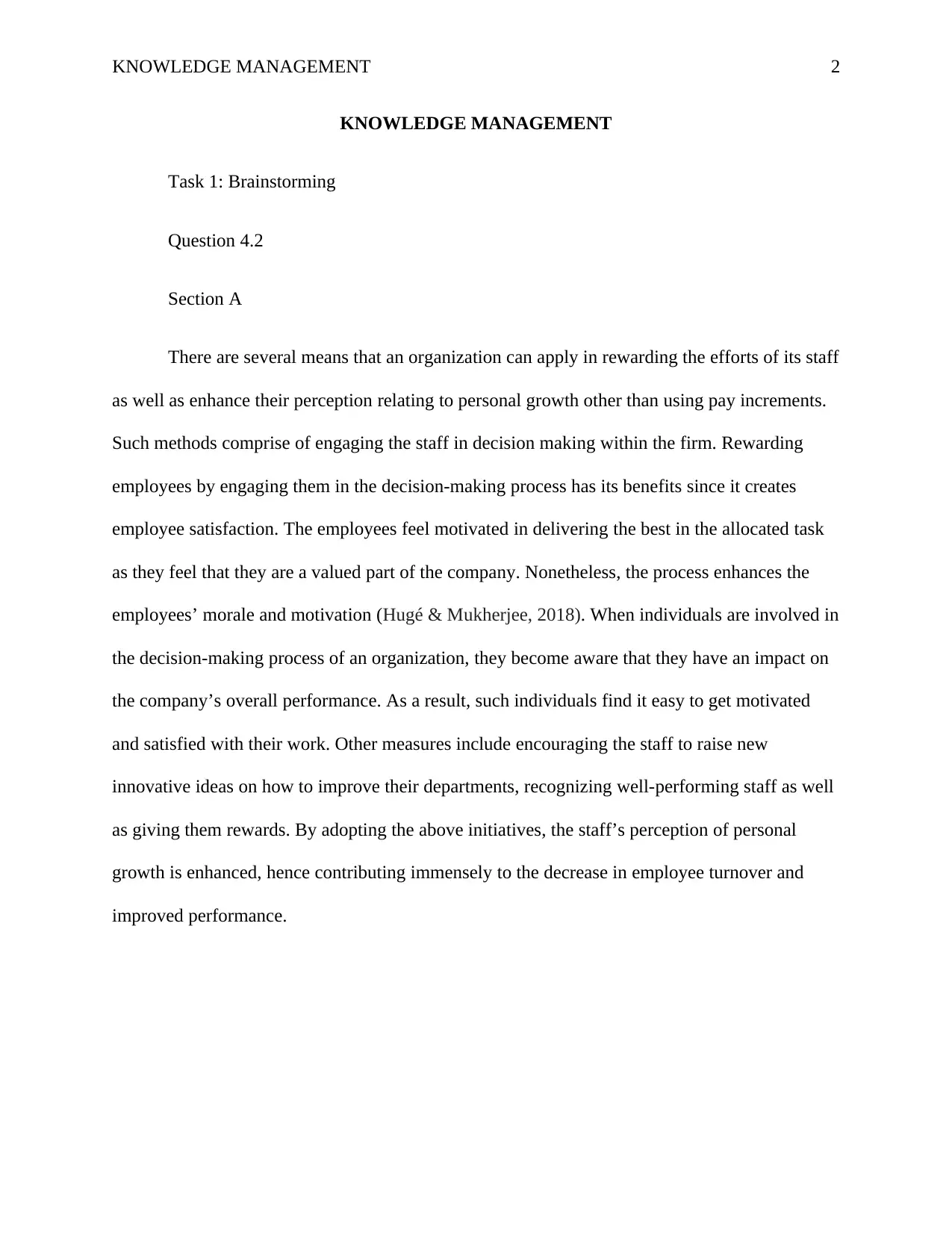
KNOWLEDGE MANAGEMENT 2
KNOWLEDGE MANAGEMENT
Task 1: Brainstorming
Question 4.2
Section A
There are several means that an organization can apply in rewarding the efforts of its staff
as well as enhance their perception relating to personal growth other than using pay increments.
Such methods comprise of engaging the staff in decision making within the firm. Rewarding
employees by engaging them in the decision-making process has its benefits since it creates
employee satisfaction. The employees feel motivated in delivering the best in the allocated task
as they feel that they are a valued part of the company. Nonetheless, the process enhances the
employees’ morale and motivation (Hugé & Mukherjee, 2018). When individuals are involved in
the decision-making process of an organization, they become aware that they have an impact on
the company’s overall performance. As a result, such individuals find it easy to get motivated
and satisfied with their work. Other measures include encouraging the staff to raise new
innovative ideas on how to improve their departments, recognizing well-performing staff as well
as giving them rewards. By adopting the above initiatives, the staff’s perception of personal
growth is enhanced, hence contributing immensely to the decrease in employee turnover and
improved performance.
KNOWLEDGE MANAGEMENT
Task 1: Brainstorming
Question 4.2
Section A
There are several means that an organization can apply in rewarding the efforts of its staff
as well as enhance their perception relating to personal growth other than using pay increments.
Such methods comprise of engaging the staff in decision making within the firm. Rewarding
employees by engaging them in the decision-making process has its benefits since it creates
employee satisfaction. The employees feel motivated in delivering the best in the allocated task
as they feel that they are a valued part of the company. Nonetheless, the process enhances the
employees’ morale and motivation (Hugé & Mukherjee, 2018). When individuals are involved in
the decision-making process of an organization, they become aware that they have an impact on
the company’s overall performance. As a result, such individuals find it easy to get motivated
and satisfied with their work. Other measures include encouraging the staff to raise new
innovative ideas on how to improve their departments, recognizing well-performing staff as well
as giving them rewards. By adopting the above initiatives, the staff’s perception of personal
growth is enhanced, hence contributing immensely to the decrease in employee turnover and
improved performance.
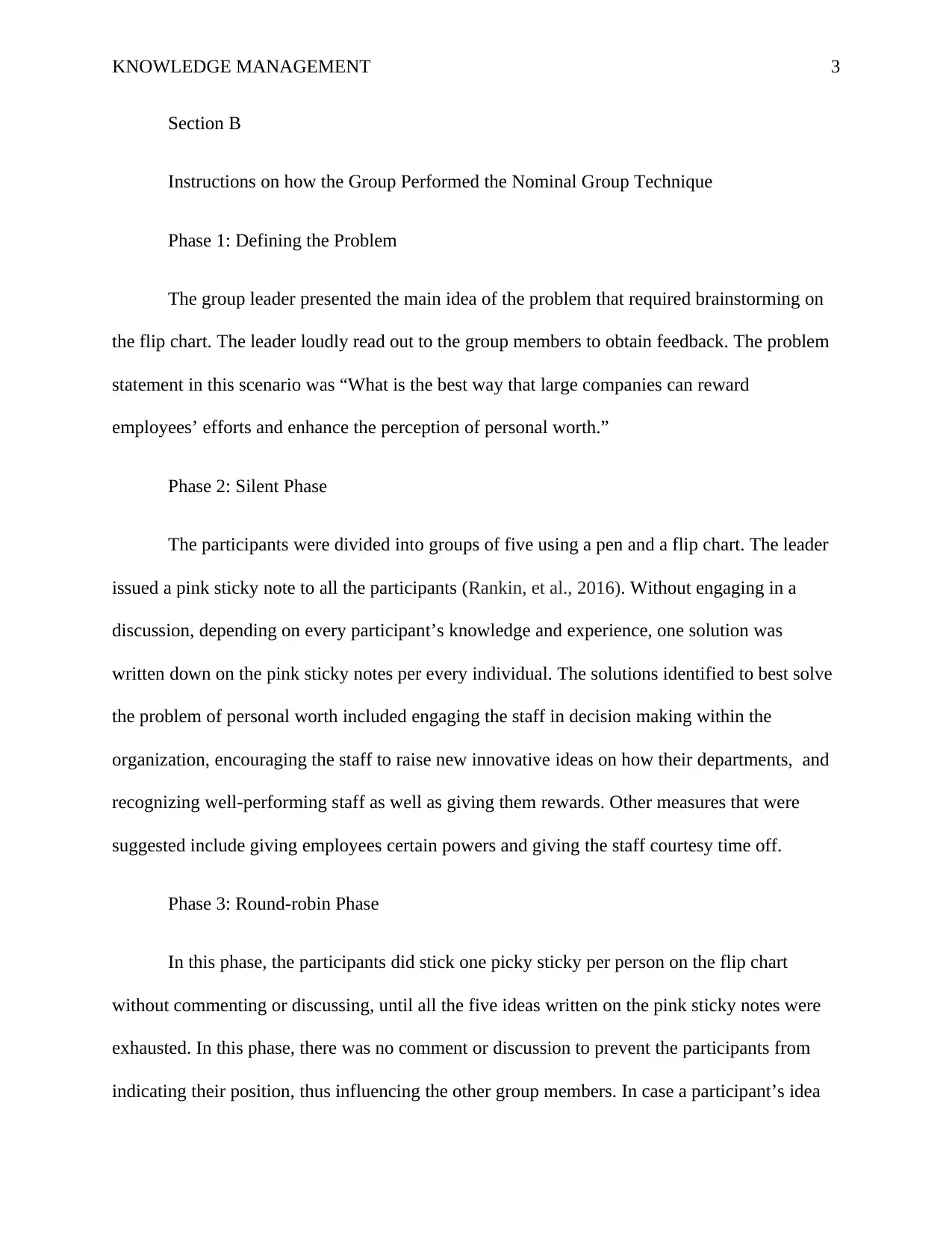
KNOWLEDGE MANAGEMENT 3
Section B
Instructions on how the Group Performed the Nominal Group Technique
Phase 1: Defining the Problem
The group leader presented the main idea of the problem that required brainstorming on
the flip chart. The leader loudly read out to the group members to obtain feedback. The problem
statement in this scenario was “What is the best way that large companies can reward
employees’ efforts and enhance the perception of personal worth.”
Phase 2: Silent Phase
The participants were divided into groups of five using a pen and a flip chart. The leader
issued a pink sticky note to all the participants (Rankin, et al., 2016). Without engaging in a
discussion, depending on every participant’s knowledge and experience, one solution was
written down on the pink sticky notes per every individual. The solutions identified to best solve
the problem of personal worth included engaging the staff in decision making within the
organization, encouraging the staff to raise new innovative ideas on how their departments, and
recognizing well-performing staff as well as giving them rewards. Other measures that were
suggested include giving employees certain powers and giving the staff courtesy time off.
Phase 3: Round-robin Phase
In this phase, the participants did stick one picky sticky per person on the flip chart
without commenting or discussing, until all the five ideas written on the pink sticky notes were
exhausted. In this phase, there was no comment or discussion to prevent the participants from
indicating their position, thus influencing the other group members. In case a participant’s idea
Section B
Instructions on how the Group Performed the Nominal Group Technique
Phase 1: Defining the Problem
The group leader presented the main idea of the problem that required brainstorming on
the flip chart. The leader loudly read out to the group members to obtain feedback. The problem
statement in this scenario was “What is the best way that large companies can reward
employees’ efforts and enhance the perception of personal worth.”
Phase 2: Silent Phase
The participants were divided into groups of five using a pen and a flip chart. The leader
issued a pink sticky note to all the participants (Rankin, et al., 2016). Without engaging in a
discussion, depending on every participant’s knowledge and experience, one solution was
written down on the pink sticky notes per every individual. The solutions identified to best solve
the problem of personal worth included engaging the staff in decision making within the
organization, encouraging the staff to raise new innovative ideas on how their departments, and
recognizing well-performing staff as well as giving them rewards. Other measures that were
suggested include giving employees certain powers and giving the staff courtesy time off.
Phase 3: Round-robin Phase
In this phase, the participants did stick one picky sticky per person on the flip chart
without commenting or discussing, until all the five ideas written on the pink sticky notes were
exhausted. In this phase, there was no comment or discussion to prevent the participants from
indicating their position, thus influencing the other group members. In case a participant’s idea
⊘ This is a preview!⊘
Do you want full access?
Subscribe today to unlock all pages.

Trusted by 1+ million students worldwide
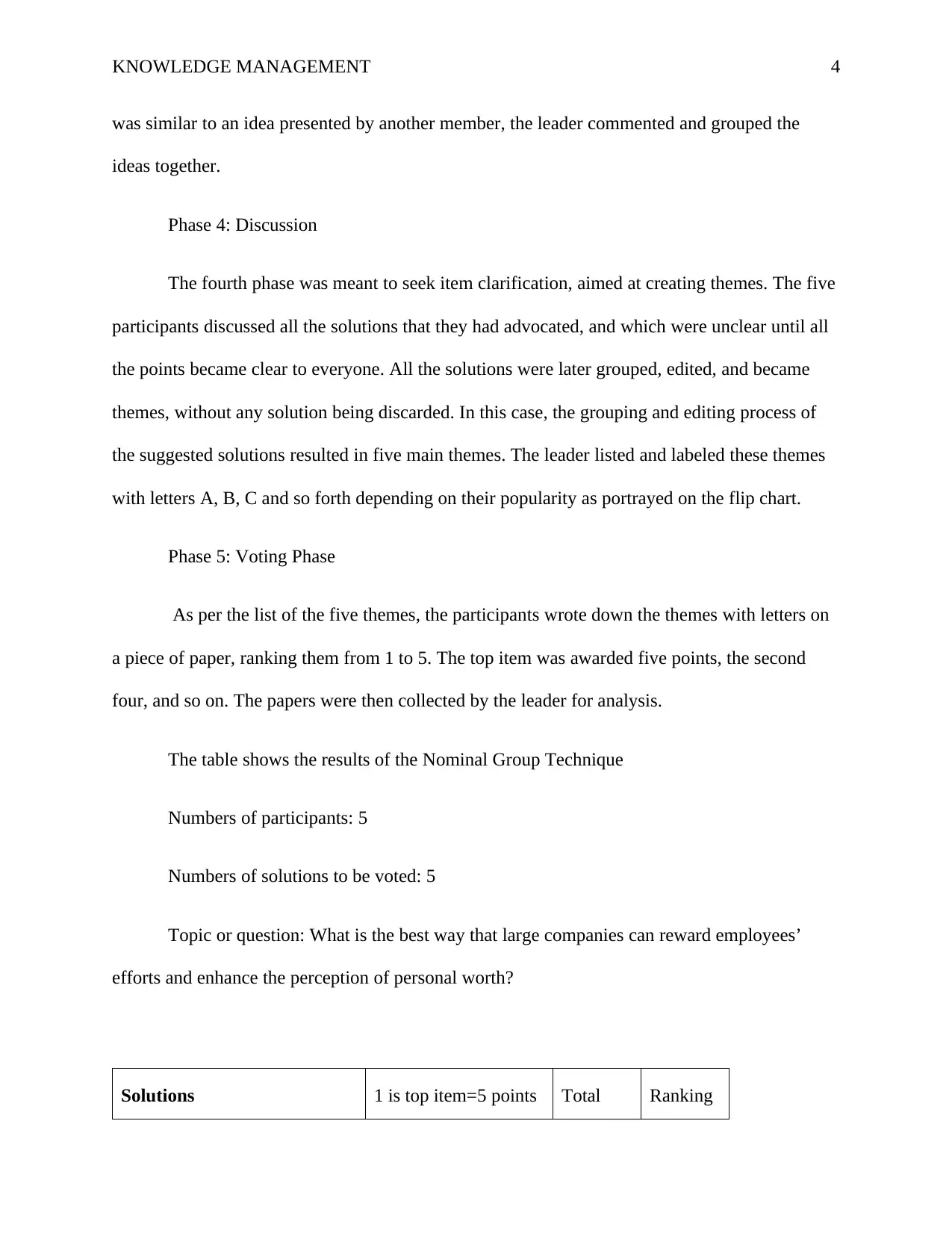
KNOWLEDGE MANAGEMENT 4
was similar to an idea presented by another member, the leader commented and grouped the
ideas together.
Phase 4: Discussion
The fourth phase was meant to seek item clarification, aimed at creating themes. The five
participants discussed all the solutions that they had advocated, and which were unclear until all
the points became clear to everyone. All the solutions were later grouped, edited, and became
themes, without any solution being discarded. In this case, the grouping and editing process of
the suggested solutions resulted in five main themes. The leader listed and labeled these themes
with letters A, B, C and so forth depending on their popularity as portrayed on the flip chart.
Phase 5: Voting Phase
As per the list of the five themes, the participants wrote down the themes with letters on
a piece of paper, ranking them from 1 to 5. The top item was awarded five points, the second
four, and so on. The papers were then collected by the leader for analysis.
The table shows the results of the Nominal Group Technique
Numbers of participants: 5
Numbers of solutions to be voted: 5
Topic or question: What is the best way that large companies can reward employees’
efforts and enhance the perception of personal worth?
Solutions 1 is top item=5 points Total Ranking
was similar to an idea presented by another member, the leader commented and grouped the
ideas together.
Phase 4: Discussion
The fourth phase was meant to seek item clarification, aimed at creating themes. The five
participants discussed all the solutions that they had advocated, and which were unclear until all
the points became clear to everyone. All the solutions were later grouped, edited, and became
themes, without any solution being discarded. In this case, the grouping and editing process of
the suggested solutions resulted in five main themes. The leader listed and labeled these themes
with letters A, B, C and so forth depending on their popularity as portrayed on the flip chart.
Phase 5: Voting Phase
As per the list of the five themes, the participants wrote down the themes with letters on
a piece of paper, ranking them from 1 to 5. The top item was awarded five points, the second
four, and so on. The papers were then collected by the leader for analysis.
The table shows the results of the Nominal Group Technique
Numbers of participants: 5
Numbers of solutions to be voted: 5
Topic or question: What is the best way that large companies can reward employees’
efforts and enhance the perception of personal worth?
Solutions 1 is top item=5 points Total Ranking
Paraphrase This Document
Need a fresh take? Get an instant paraphrase of this document with our AI Paraphraser
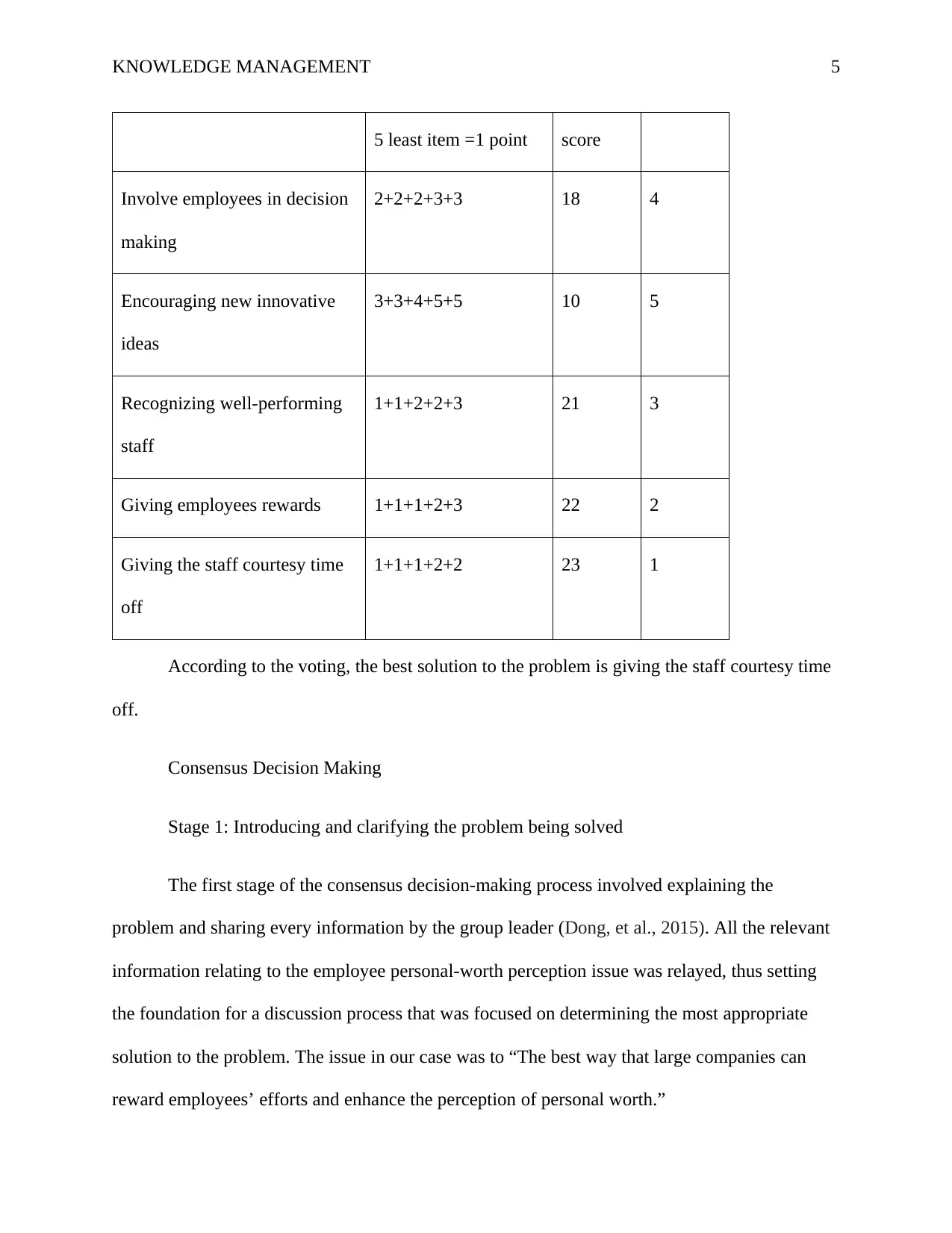
KNOWLEDGE MANAGEMENT 5
5 least item =1 point score
Involve employees in decision
making
2+2+2+3+3 18 4
Encouraging new innovative
ideas
3+3+4+5+5 10 5
Recognizing well-performing
staff
1+1+2+2+3 21 3
Giving employees rewards 1+1+1+2+3 22 2
Giving the staff courtesy time
off
1+1+1+2+2 23 1
According to the voting, the best solution to the problem is giving the staff courtesy time
off.
Consensus Decision Making
Stage 1: Introducing and clarifying the problem being solved
The first stage of the consensus decision-making process involved explaining the
problem and sharing every information by the group leader (Dong, et al., 2015). All the relevant
information relating to the employee personal-worth perception issue was relayed, thus setting
the foundation for a discussion process that was focused on determining the most appropriate
solution to the problem. The issue in our case was to “The best way that large companies can
reward employees’ efforts and enhance the perception of personal worth.”
5 least item =1 point score
Involve employees in decision
making
2+2+2+3+3 18 4
Encouraging new innovative
ideas
3+3+4+5+5 10 5
Recognizing well-performing
staff
1+1+2+2+3 21 3
Giving employees rewards 1+1+1+2+3 22 2
Giving the staff courtesy time
off
1+1+1+2+2 23 1
According to the voting, the best solution to the problem is giving the staff courtesy time
off.
Consensus Decision Making
Stage 1: Introducing and clarifying the problem being solved
The first stage of the consensus decision-making process involved explaining the
problem and sharing every information by the group leader (Dong, et al., 2015). All the relevant
information relating to the employee personal-worth perception issue was relayed, thus setting
the foundation for a discussion process that was focused on determining the most appropriate
solution to the problem. The issue in our case was to “The best way that large companies can
reward employees’ efforts and enhance the perception of personal worth.”
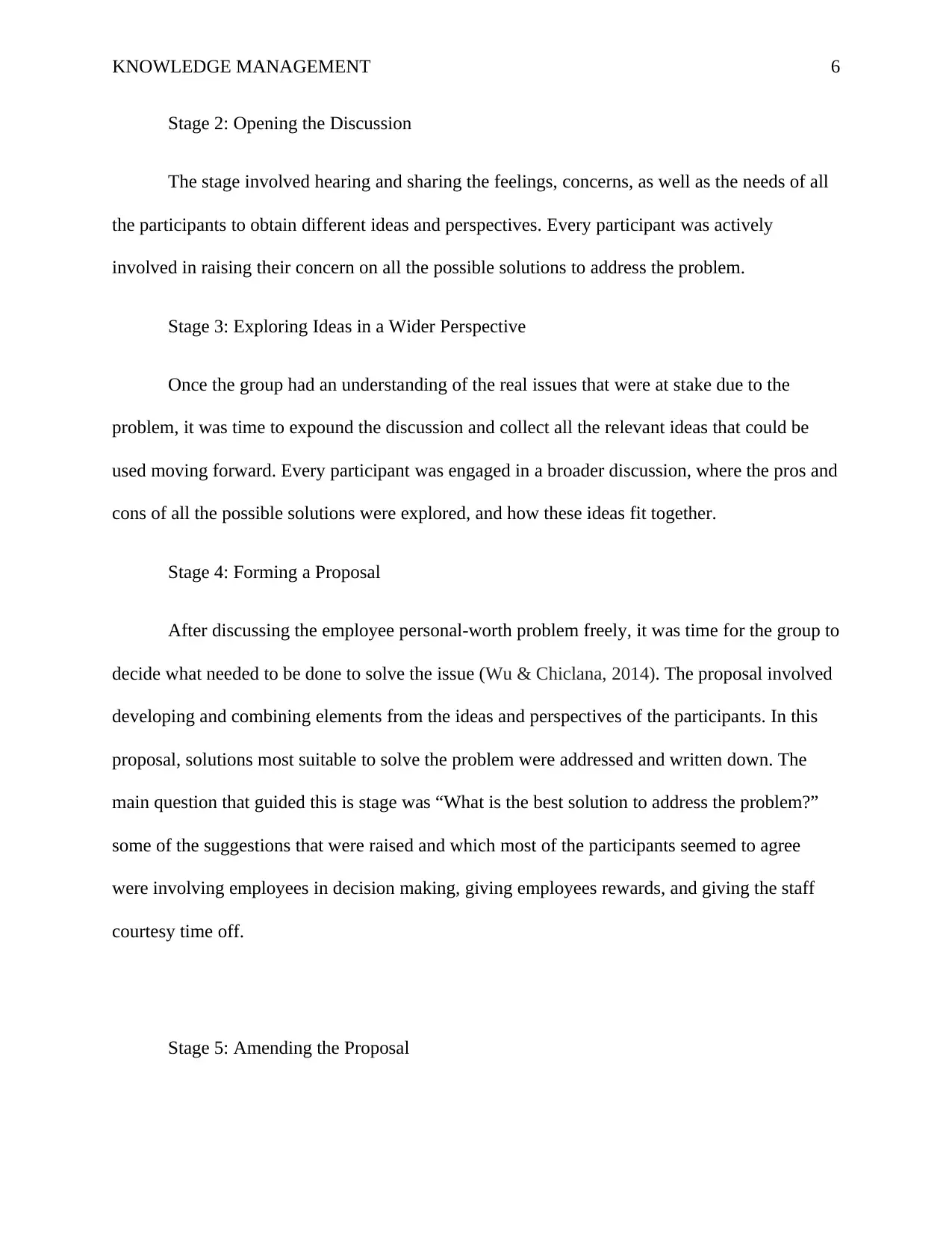
KNOWLEDGE MANAGEMENT 6
Stage 2: Opening the Discussion
The stage involved hearing and sharing the feelings, concerns, as well as the needs of all
the participants to obtain different ideas and perspectives. Every participant was actively
involved in raising their concern on all the possible solutions to address the problem.
Stage 3: Exploring Ideas in a Wider Perspective
Once the group had an understanding of the real issues that were at stake due to the
problem, it was time to expound the discussion and collect all the relevant ideas that could be
used moving forward. Every participant was engaged in a broader discussion, where the pros and
cons of all the possible solutions were explored, and how these ideas fit together.
Stage 4: Forming a Proposal
After discussing the employee personal-worth problem freely, it was time for the group to
decide what needed to be done to solve the issue (Wu & Chiclana, 2014). The proposal involved
developing and combining elements from the ideas and perspectives of the participants. In this
proposal, solutions most suitable to solve the problem were addressed and written down. The
main question that guided this is stage was “What is the best solution to address the problem?”
some of the suggestions that were raised and which most of the participants seemed to agree
were involving employees in decision making, giving employees rewards, and giving the staff
courtesy time off.
Stage 5: Amending the Proposal
Stage 2: Opening the Discussion
The stage involved hearing and sharing the feelings, concerns, as well as the needs of all
the participants to obtain different ideas and perspectives. Every participant was actively
involved in raising their concern on all the possible solutions to address the problem.
Stage 3: Exploring Ideas in a Wider Perspective
Once the group had an understanding of the real issues that were at stake due to the
problem, it was time to expound the discussion and collect all the relevant ideas that could be
used moving forward. Every participant was engaged in a broader discussion, where the pros and
cons of all the possible solutions were explored, and how these ideas fit together.
Stage 4: Forming a Proposal
After discussing the employee personal-worth problem freely, it was time for the group to
decide what needed to be done to solve the issue (Wu & Chiclana, 2014). The proposal involved
developing and combining elements from the ideas and perspectives of the participants. In this
proposal, solutions most suitable to solve the problem were addressed and written down. The
main question that guided this is stage was “What is the best solution to address the problem?”
some of the suggestions that were raised and which most of the participants seemed to agree
were involving employees in decision making, giving employees rewards, and giving the staff
courtesy time off.
Stage 5: Amending the Proposal
⊘ This is a preview!⊘
Do you want full access?
Subscribe today to unlock all pages.

Trusted by 1+ million students worldwide
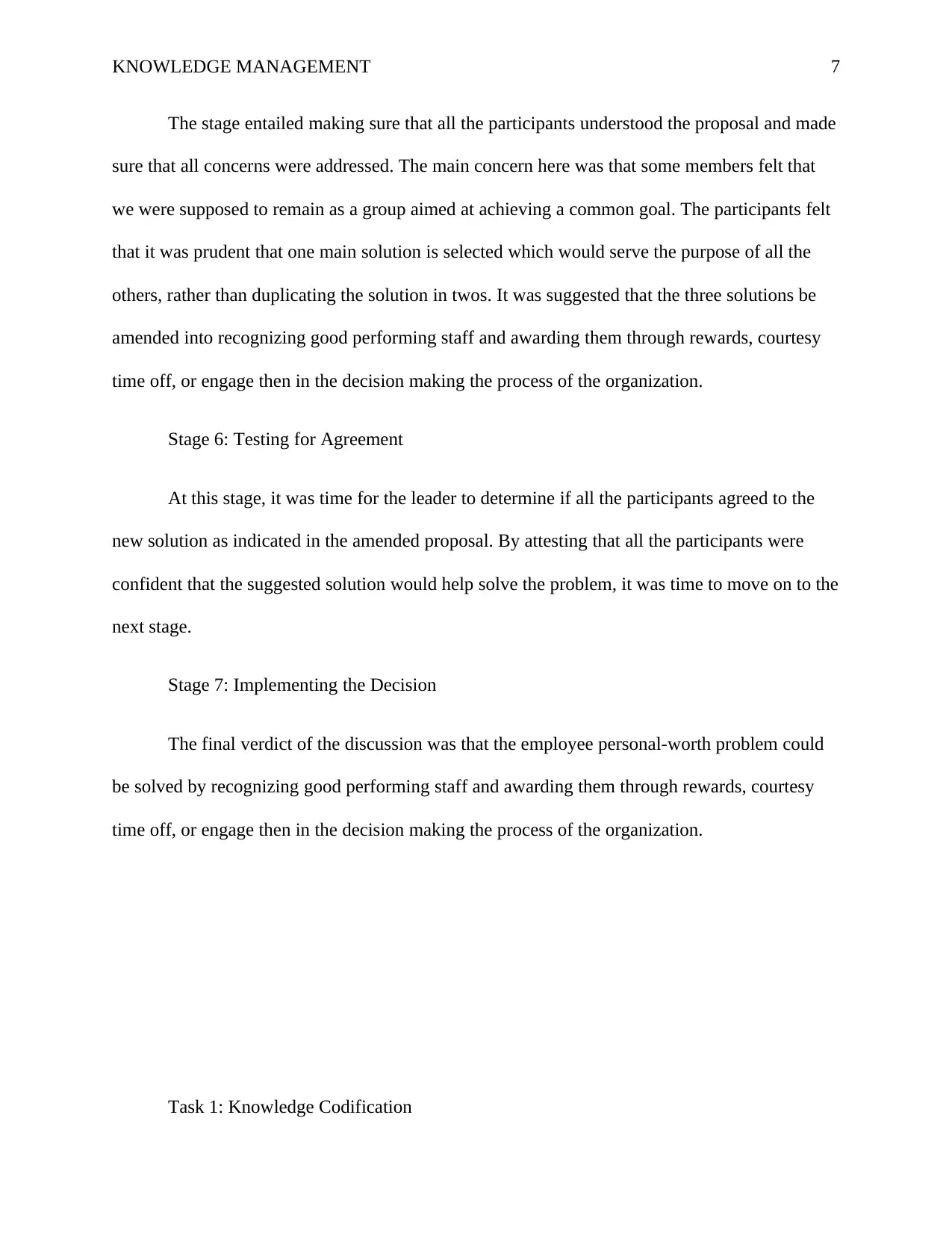
KNOWLEDGE MANAGEMENT 7
The stage entailed making sure that all the participants understood the proposal and made
sure that all concerns were addressed. The main concern here was that some members felt that
we were supposed to remain as a group aimed at achieving a common goal. The participants felt
that it was prudent that one main solution is selected which would serve the purpose of all the
others, rather than duplicating the solution in twos. It was suggested that the three solutions be
amended into recognizing good performing staff and awarding them through rewards, courtesy
time off, or engage then in the decision making the process of the organization.
Stage 6: Testing for Agreement
At this stage, it was time for the leader to determine if all the participants agreed to the
new solution as indicated in the amended proposal. By attesting that all the participants were
confident that the suggested solution would help solve the problem, it was time to move on to the
next stage.
Stage 7: Implementing the Decision
The final verdict of the discussion was that the employee personal-worth problem could
be solved by recognizing good performing staff and awarding them through rewards, courtesy
time off, or engage then in the decision making the process of the organization.
Task 1: Knowledge Codification
The stage entailed making sure that all the participants understood the proposal and made
sure that all concerns were addressed. The main concern here was that some members felt that
we were supposed to remain as a group aimed at achieving a common goal. The participants felt
that it was prudent that one main solution is selected which would serve the purpose of all the
others, rather than duplicating the solution in twos. It was suggested that the three solutions be
amended into recognizing good performing staff and awarding them through rewards, courtesy
time off, or engage then in the decision making the process of the organization.
Stage 6: Testing for Agreement
At this stage, it was time for the leader to determine if all the participants agreed to the
new solution as indicated in the amended proposal. By attesting that all the participants were
confident that the suggested solution would help solve the problem, it was time to move on to the
next stage.
Stage 7: Implementing the Decision
The final verdict of the discussion was that the employee personal-worth problem could
be solved by recognizing good performing staff and awarding them through rewards, courtesy
time off, or engage then in the decision making the process of the organization.
Task 1: Knowledge Codification
Paraphrase This Document
Need a fresh take? Get an instant paraphrase of this document with our AI Paraphraser
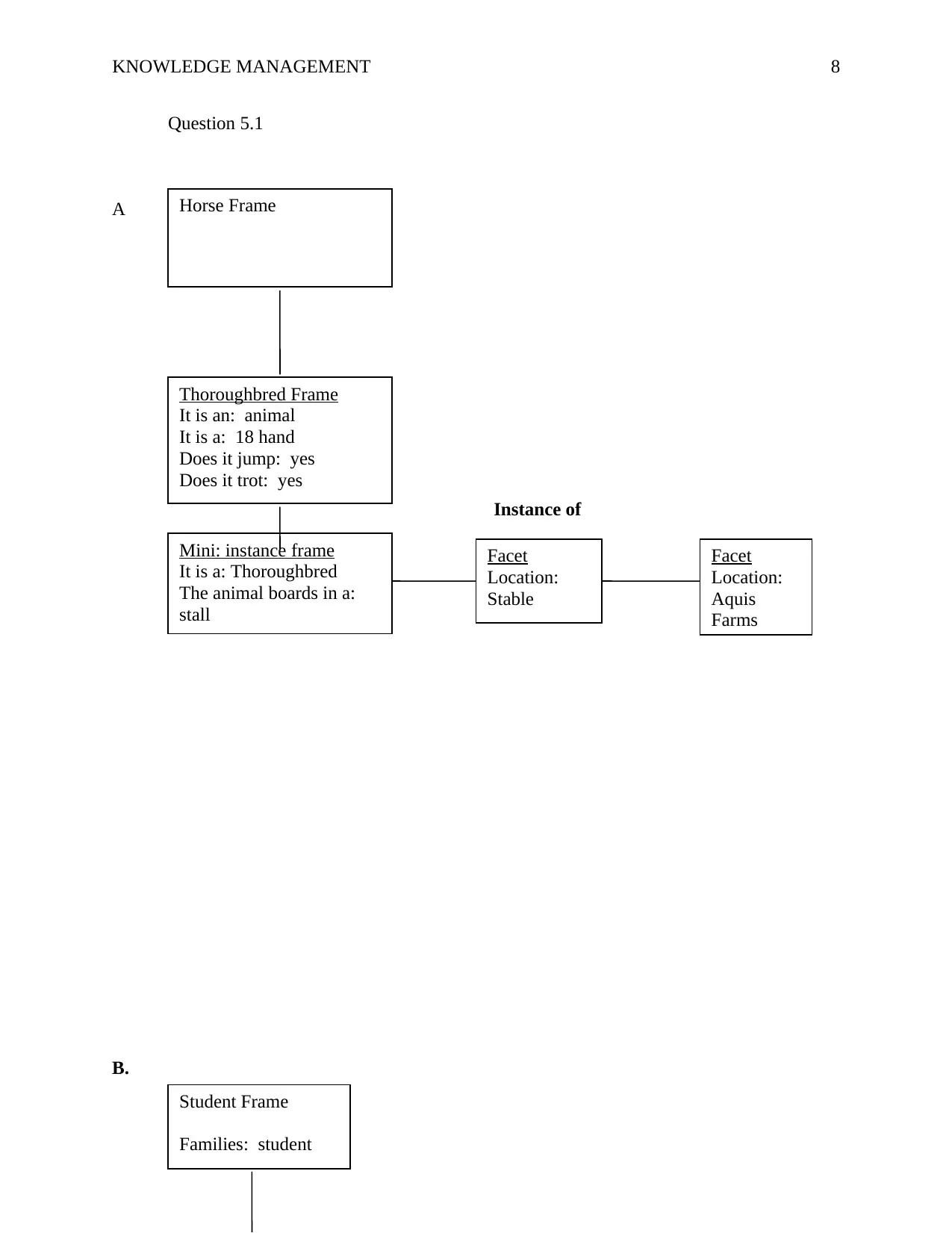
KNOWLEDGE MANAGEMENT 8
Question 5.1
A
Instance of
B.
Student Frame
Families: student
Facet
Location:
Stable
Mini: instance frame
It is a: Thoroughbred
The animal boards in a:
stall
Facet
Location:
Aquis
Farms
Families: Thoroughbred
Thoroughbred Frame
It is an: animal
It is a: 18 hand
Does it jump: yes
Does it trot: yes
Horse Frame
Question 5.1
A
Instance of
B.
Student Frame
Families: student
Facet
Location:
Stable
Mini: instance frame
It is a: Thoroughbred
The animal boards in a:
stall
Facet
Location:
Aquis
Farms
Families: Thoroughbred
Thoroughbred Frame
It is an: animal
It is a: 18 hand
Does it jump: yes
Does it trot: yes
Horse Frame
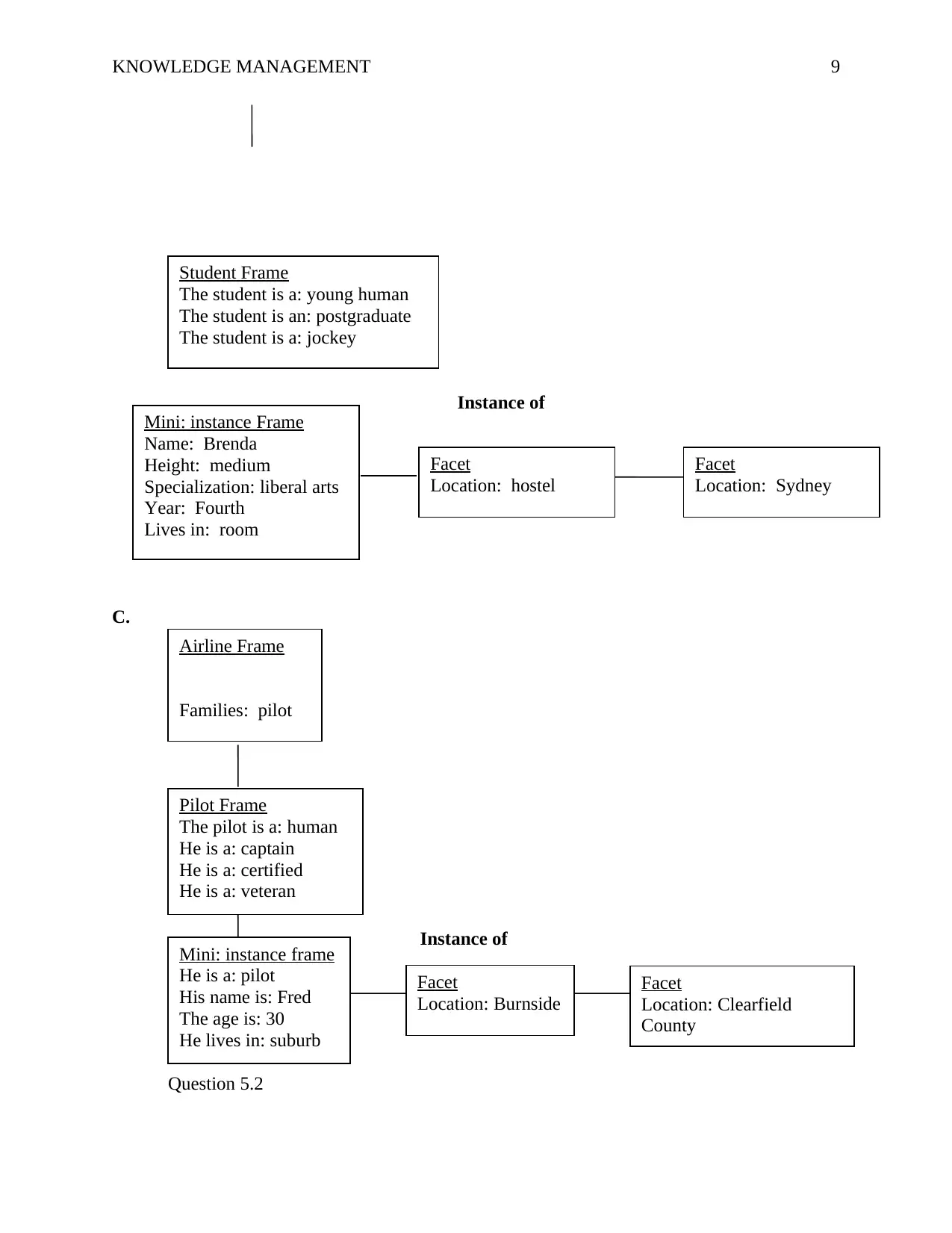
KNOWLEDGE MANAGEMENT 9
Instance of
C.
Instance of
Question 5.2
Facet
Location: Clearfield
County
Mini: instance frame
He is a: pilot
His name is: Fred
The age is: 30
He lives in: suburb
Facet
Location: Burnside
Pilot Frame
The pilot is a: human
He is a: captain
He is a: certified
He is a: veteran
Airline Frame
Families: pilot
Facet
Location: Sydney
Facet
Location: hostel
Mini: instance Frame
Name: Brenda
Height: medium
Specialization: liberal arts
Year: Fourth
Lives in: room
Student Frame
The student is a: young human
The student is an: postgraduate
The student is a: jockey
Instance of
C.
Instance of
Question 5.2
Facet
Location: Clearfield
County
Mini: instance frame
He is a: pilot
His name is: Fred
The age is: 30
He lives in: suburb
Facet
Location: Burnside
Pilot Frame
The pilot is a: human
He is a: captain
He is a: certified
He is a: veteran
Airline Frame
Families: pilot
Facet
Location: Sydney
Facet
Location: hostel
Mini: instance Frame
Name: Brenda
Height: medium
Specialization: liberal arts
Year: Fourth
Lives in: room
Student Frame
The student is a: young human
The student is an: postgraduate
The student is a: jockey
⊘ This is a preview!⊘
Do you want full access?
Subscribe today to unlock all pages.

Trusted by 1+ million students worldwide
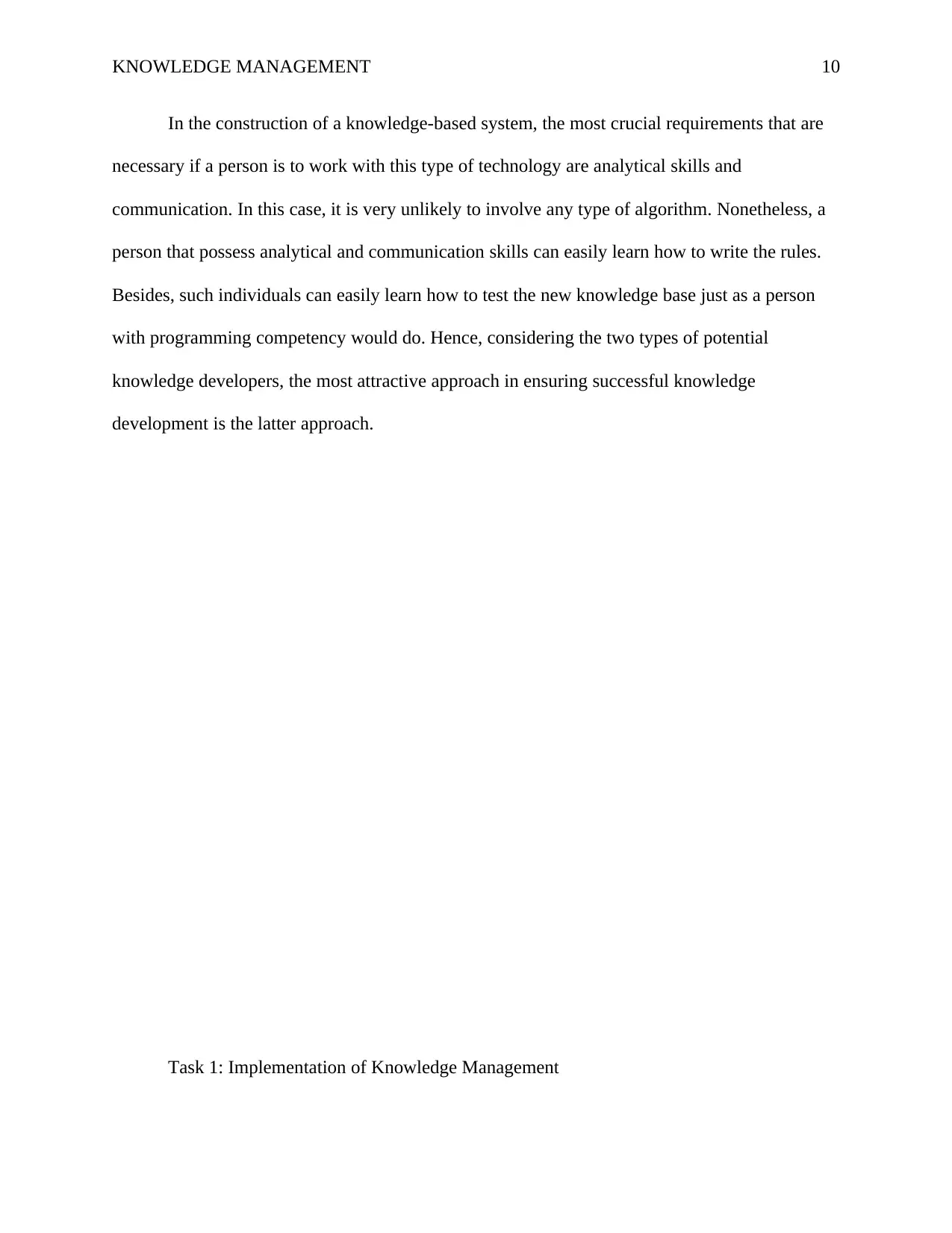
KNOWLEDGE MANAGEMENT 10
In the construction of a knowledge-based system, the most crucial requirements that are
necessary if a person is to work with this type of technology are analytical skills and
communication. In this case, it is very unlikely to involve any type of algorithm. Nonetheless, a
person that possess analytical and communication skills can easily learn how to write the rules.
Besides, such individuals can easily learn how to test the new knowledge base just as a person
with programming competency would do. Hence, considering the two types of potential
knowledge developers, the most attractive approach in ensuring successful knowledge
development is the latter approach.
Task 1: Implementation of Knowledge Management
In the construction of a knowledge-based system, the most crucial requirements that are
necessary if a person is to work with this type of technology are analytical skills and
communication. In this case, it is very unlikely to involve any type of algorithm. Nonetheless, a
person that possess analytical and communication skills can easily learn how to write the rules.
Besides, such individuals can easily learn how to test the new knowledge base just as a person
with programming competency would do. Hence, considering the two types of potential
knowledge developers, the most attractive approach in ensuring successful knowledge
development is the latter approach.
Task 1: Implementation of Knowledge Management
Paraphrase This Document
Need a fresh take? Get an instant paraphrase of this document with our AI Paraphraser
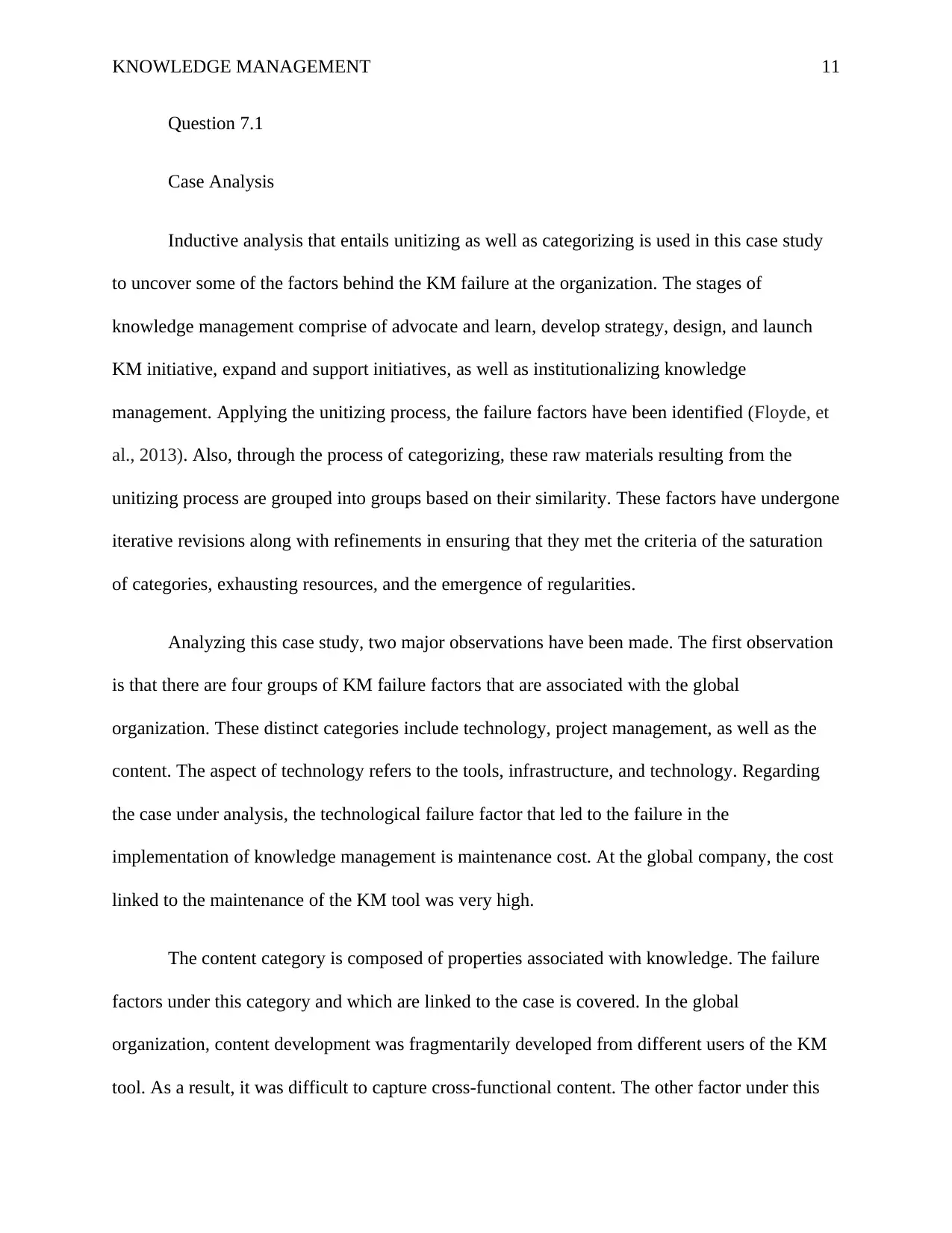
KNOWLEDGE MANAGEMENT 11
Question 7.1
Case Analysis
Inductive analysis that entails unitizing as well as categorizing is used in this case study
to uncover some of the factors behind the KM failure at the organization. The stages of
knowledge management comprise of advocate and learn, develop strategy, design, and launch
KM initiative, expand and support initiatives, as well as institutionalizing knowledge
management. Applying the unitizing process, the failure factors have been identified (Floyde, et
al., 2013). Also, through the process of categorizing, these raw materials resulting from the
unitizing process are grouped into groups based on their similarity. These factors have undergone
iterative revisions along with refinements in ensuring that they met the criteria of the saturation
of categories, exhausting resources, and the emergence of regularities.
Analyzing this case study, two major observations have been made. The first observation
is that there are four groups of KM failure factors that are associated with the global
organization. These distinct categories include technology, project management, as well as the
content. The aspect of technology refers to the tools, infrastructure, and technology. Regarding
the case under analysis, the technological failure factor that led to the failure in the
implementation of knowledge management is maintenance cost. At the global company, the cost
linked to the maintenance of the KM tool was very high.
The content category is composed of properties associated with knowledge. The failure
factors under this category and which are linked to the case is covered. In the global
organization, content development was fragmentarily developed from different users of the KM
tool. As a result, it was difficult to capture cross-functional content. The other factor under this
Question 7.1
Case Analysis
Inductive analysis that entails unitizing as well as categorizing is used in this case study
to uncover some of the factors behind the KM failure at the organization. The stages of
knowledge management comprise of advocate and learn, develop strategy, design, and launch
KM initiative, expand and support initiatives, as well as institutionalizing knowledge
management. Applying the unitizing process, the failure factors have been identified (Floyde, et
al., 2013). Also, through the process of categorizing, these raw materials resulting from the
unitizing process are grouped into groups based on their similarity. These factors have undergone
iterative revisions along with refinements in ensuring that they met the criteria of the saturation
of categories, exhausting resources, and the emergence of regularities.
Analyzing this case study, two major observations have been made. The first observation
is that there are four groups of KM failure factors that are associated with the global
organization. These distinct categories include technology, project management, as well as the
content. The aspect of technology refers to the tools, infrastructure, and technology. Regarding
the case under analysis, the technological failure factor that led to the failure in the
implementation of knowledge management is maintenance cost. At the global company, the cost
linked to the maintenance of the KM tool was very high.
The content category is composed of properties associated with knowledge. The failure
factors under this category and which are linked to the case is covered. In the global
organization, content development was fragmentarily developed from different users of the KM
tool. As a result, it was difficult to capture cross-functional content. The other factor under this
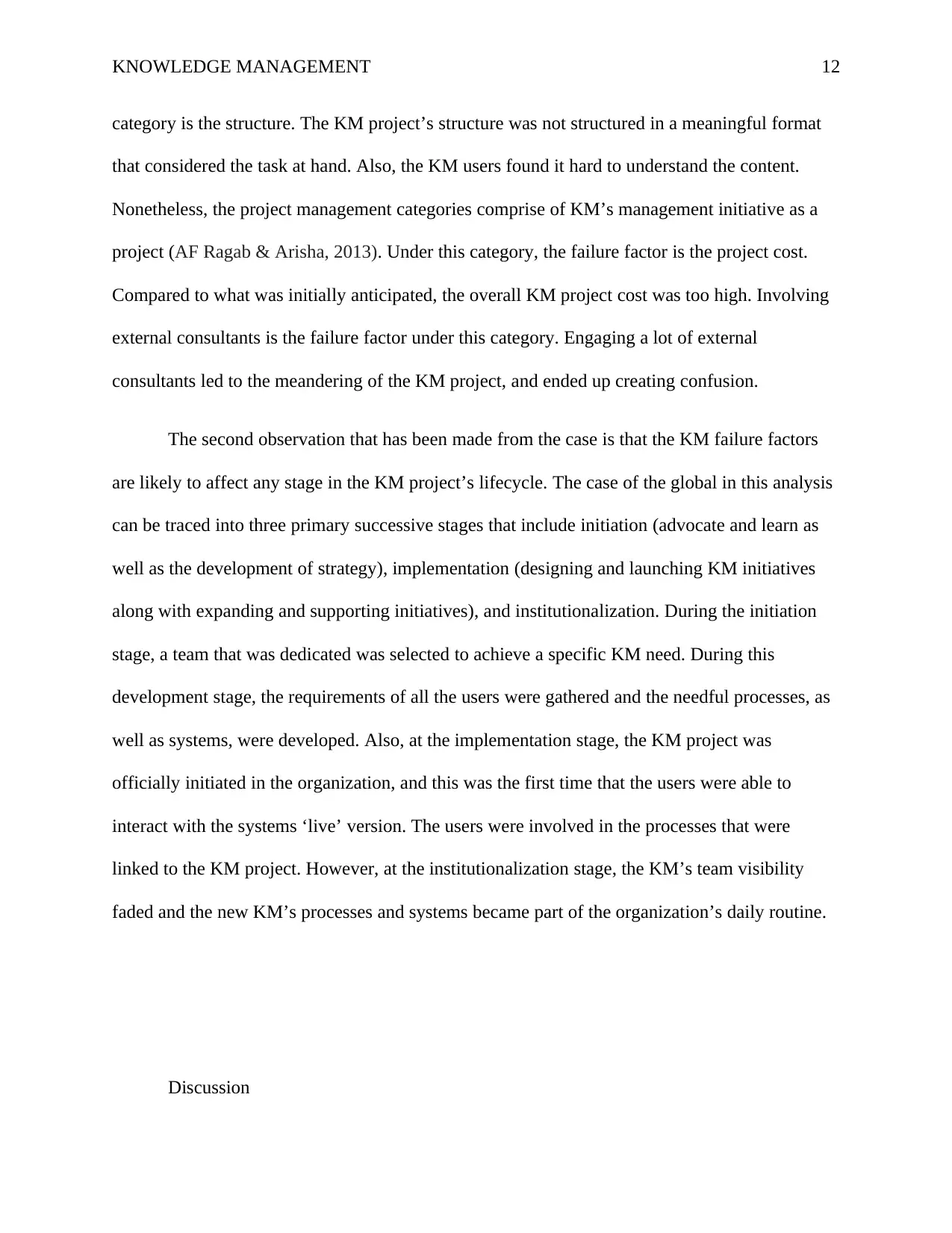
KNOWLEDGE MANAGEMENT 12
category is the structure. The KM project’s structure was not structured in a meaningful format
that considered the task at hand. Also, the KM users found it hard to understand the content.
Nonetheless, the project management categories comprise of KM’s management initiative as a
project (AF Ragab & Arisha, 2013). Under this category, the failure factor is the project cost.
Compared to what was initially anticipated, the overall KM project cost was too high. Involving
external consultants is the failure factor under this category. Engaging a lot of external
consultants led to the meandering of the KM project, and ended up creating confusion.
The second observation that has been made from the case is that the KM failure factors
are likely to affect any stage in the KM project’s lifecycle. The case of the global in this analysis
can be traced into three primary successive stages that include initiation (advocate and learn as
well as the development of strategy), implementation (designing and launching KM initiatives
along with expanding and supporting initiatives), and institutionalization. During the initiation
stage, a team that was dedicated was selected to achieve a specific KM need. During this
development stage, the requirements of all the users were gathered and the needful processes, as
well as systems, were developed. Also, at the implementation stage, the KM project was
officially initiated in the organization, and this was the first time that the users were able to
interact with the systems ‘live’ version. The users were involved in the processes that were
linked to the KM project. However, at the institutionalization stage, the KM’s team visibility
faded and the new KM’s processes and systems became part of the organization’s daily routine.
Discussion
category is the structure. The KM project’s structure was not structured in a meaningful format
that considered the task at hand. Also, the KM users found it hard to understand the content.
Nonetheless, the project management categories comprise of KM’s management initiative as a
project (AF Ragab & Arisha, 2013). Under this category, the failure factor is the project cost.
Compared to what was initially anticipated, the overall KM project cost was too high. Involving
external consultants is the failure factor under this category. Engaging a lot of external
consultants led to the meandering of the KM project, and ended up creating confusion.
The second observation that has been made from the case is that the KM failure factors
are likely to affect any stage in the KM project’s lifecycle. The case of the global in this analysis
can be traced into three primary successive stages that include initiation (advocate and learn as
well as the development of strategy), implementation (designing and launching KM initiatives
along with expanding and supporting initiatives), and institutionalization. During the initiation
stage, a team that was dedicated was selected to achieve a specific KM need. During this
development stage, the requirements of all the users were gathered and the needful processes, as
well as systems, were developed. Also, at the implementation stage, the KM project was
officially initiated in the organization, and this was the first time that the users were able to
interact with the systems ‘live’ version. The users were involved in the processes that were
linked to the KM project. However, at the institutionalization stage, the KM’s team visibility
faded and the new KM’s processes and systems became part of the organization’s daily routine.
Discussion
⊘ This is a preview!⊘
Do you want full access?
Subscribe today to unlock all pages.

Trusted by 1+ million students worldwide
1 out of 15
Related Documents
Your All-in-One AI-Powered Toolkit for Academic Success.
+13062052269
info@desklib.com
Available 24*7 on WhatsApp / Email
![[object Object]](/_next/static/media/star-bottom.7253800d.svg)
Unlock your academic potential
Copyright © 2020–2025 A2Z Services. All Rights Reserved. Developed and managed by ZUCOL.




